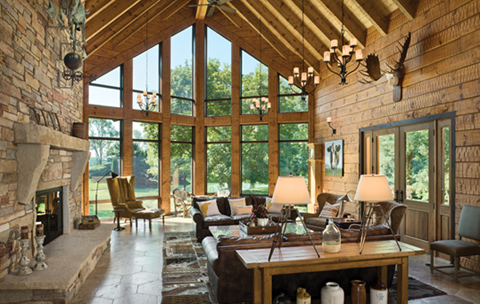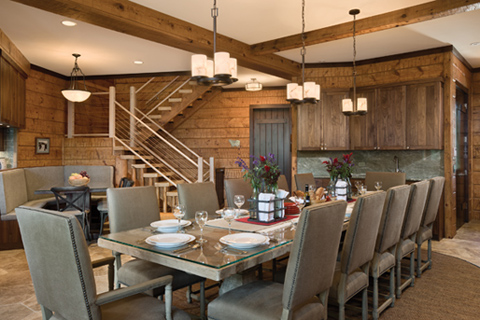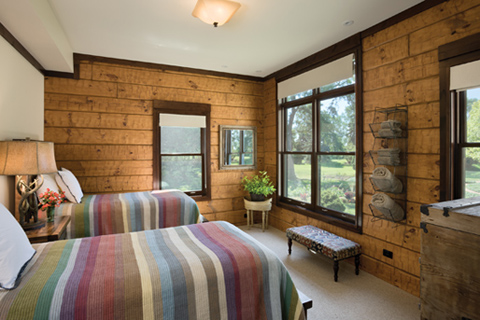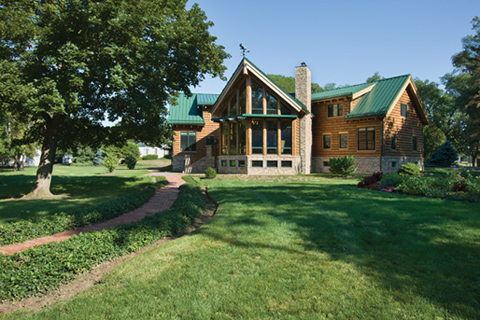“Our client chose full logs for their family house,” says Dennis Davis, project manager for RJ Dailey Construction, “believing the aesthetics would make the proper statement about family and farm values: strong, stable and, most of all, enduring.”
RJ Dailey builds only custom residences and estates, says Davis, “but up until now only in California, where our company is based.” It was an honor and a pleasure for the company to be selected as the general contractor for a log home on a family farm in Illinois, with Davis heading up the project. “I have been working [with RJ Dailey] for this client on and off over the past 20 years, on their primary residence in California. The process of building a log home for them was very new to me, and what a process it was!”
Log wall assembly, screw jacks for adjusting the home to keep it level as it settles and “shrinks,” installing slip joints in plumbing and electrical runs between floors, as well as an education in Illinois state building codes were all components that were part of Davis’s nearly vertical learning curve.

“I also had a lot to learn about Illinois weather and pests,” Davis admits. “Fortunately, the farm hands and local subcontractors were more than willing to teach a couple of ‘Westerners’ the ropes, and my client was correct in claiming that the skill level of contractors in the area was very similar to what I’m accustomed to in the Bay Area: outstanding!
Darrell Karstensen of DK Log Construction is a veteran log home builder with 25 years of experience and 45 log structures under his belt. Based in Beecher, Illinois, about 35 miles south of Chicago, Karstensen completed all of the log stacking, timber work, and finish carpentry in the home. “It was a complex project, to be sure,” the builder says, “but all of the pieces came together. I was on the job for about six or seven months. Dennis Davis was a great organizer when it came to keeping things running smoothly and on schedule.”
Because of the complexity of the 11,000-square-foot log home design, Davis and his wife, Jeanne, elected to live in guest quarters on the farm during the course of the construction, with bimonthly returns to California to visit their family. Their involvement began in mid-April of 2010, when they started interviewing contractors, obtaining building permits, and getting the engineering and floorplans pulled together. “It was during this period that I approved Expedition Log Homes’ shop drawings and added several custom features to both the interior and exterior woodworking,” reports Davis. “Everything was approved by my client via face-to-face meetings in California, or e-mails. Expedition was able to accommodate all of our client’s aesthetic desires, as well as our architect’s structural needs.”

The architectural plans called for a full 10-inch D-log with a dovetail corner, which Expedition had not yet produced. “This was not the first time we created a new style to meet a client’s expectations,” says Expedition Log Homes’ co-owner and production manager, Mac Garcia. “To quote Plato, “Necessity is the Mother of Invention.’ I was initially forwarded a picture of the corner look that they were interested in, along with some basic details, including a 10-inch full D-log. With the client’s parameters and input from our in-house design manager, Craig Seider, regarding energy and structural requirements, we went about creating some sample pieces.” This step was crucial. It allowed Garcia to get a handle on the tooling process and log specifications necessary for the job. A sample mock-up of the actual corner was presented for the client’s review. Once the overall look was approved the project moved forward to pricing and design.
“The initial goal was to implement our full log system without having to alter the architect’s original design or vision,” elaborates Expedition’s Craig Seider. “From my point of view, the most unique quality of the home is the contrasting styles that you see throughout: touches of modern architecture paired with the rustic full-log structure; clean lines contrasted with natural ‘imperfect’ material.” Seider says his biggest challenge was getting their proven full log structural system to work within the confines of the architect’s already complete and approved design. “We were able to accommodate that,” he says, “and the end result is stunning!”
Expedition’s co-owner and sales manager, Greg Grimes, adds, “Craig actually made numerous suggestions to the architectural firm, Thomas Kapausta Architects, out of Chicago. Many of them were ultimately incorporated into the plan. One of the more interesting aspects of this project was the combination of a full log primary structure attached to an angled half-log prow. Many full log structures include framed gable end walls with half-log siding, but very few combine both aspects on the main level.” A significant challenge, in addition to creating the new log style, was the complexity of angle corners specified by the architect. “Several of the corners were at 135 degrees,” says Grimes, “complex and challenging to construct.”

Even though the design arrived at Expedition as approved architectural plans, it took an additional six to eight months for the plan to be finalized and approved by all parties involved in the project. Construction started at the end of July 2010. The home was set up with temporary kitchen and laundry facilities for the family to use on vacation in August 2011 and then completely finished for a big family celebration at Thanksgiving.
Clean up and accessorizing were completed before Christmas of that same year. “Then Jeanne and I headed home to California,” says Dennis Davis. “Construction of the home was steady during all weather conditions, thanks to DK Log Construction and the tenacity and cooperation of all of the other contractors. Winter in Illinois is beautiful but challenging for construction progress. I learned, too late, that shoveling snow is a young man’s job!”
Photography by Roger Wade Studio

